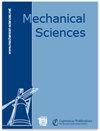基于TGA的平面4R连杆机构四位置综合解映射法
IF 1.5
4区 工程技术
Q4 ENGINEERING, MECHANICAL
引用次数: 0
摘要
摘要在本研究中,作者提出了一种基于端粒遗传算法(TGA)的解决方案图,以提高4R连锁合成的效率。首先,利用射影几何得到中心曲线上的点,通过向量消去得到圆曲线上的那些点。其次,介绍了连杆类型的定义、连杆性能的评估以及识别连杆缺陷的方法。第三,提出了解映射方法,该方法可以将中心曲线上所有点的组合获得的连杆解映射到三维彩色编码表面,以表示具有不同连杆属性的解在解域中的分布。第四,我们使用所提出的端粒算子和伪直方图方法来改进传统的遗传算法,并利用TGA扩展了解映射的解域。最后,基于解映射方法开发了连杆机构综合软件BurLink。结果表明,基于TGA的解映射可以在解域中快速定位所需的4R链接解,并为工程师提供比传统方法更多的候选解。本文章由计算机程序翻译,如有差异,请以英文原文为准。
TGA-based solutions map method for four-position synthesis of planar 4R linkage
Abstract. In this study, the authors propose a solutions map based on a telomere genetic algorithm (TGA) to improve the efficiency of 4R-linkage synthesis. First, the points on the center curve are obtained by using projective geometry, and those of the circle curve are obtained by vector elimination. Second, the definition of the linkage type, assessment of linkage performance, and a method to identify defects in the linkage are introduced. Third, the solutions map method is proposed that can map the linkage solutions obtained by all combinations of the points on the center curve to a 3D color-coded surface to represent the distribution of solutions with different attributes of linkages in the solution domain. Fourth, we use the proposed telomere operator and pseudo-histogram method to improve the traditional genetic algorithm, and expand the domain of solutions of the solutions map by using the TGA. Finally, the linkage synthesis software BurLink is developed based on the solutions map method. The results show that the TGA-based solutions map can quickly locate the required 4R-linkage solution in the solution domain, and provides engineers with more candidate solutions than traditional methods.
求助全文
通过发布文献求助,成功后即可免费获取论文全文。
去求助
来源期刊

Mechanical Sciences
ENGINEERING, MECHANICAL-
CiteScore
2.20
自引率
7.10%
发文量
74
审稿时长
29 weeks
期刊介绍:
The journal Mechanical Sciences (MS) is an international forum for the dissemination of original contributions in the field of theoretical and applied mechanics. Its main ambition is to provide a platform for young researchers to build up a portfolio of high-quality peer-reviewed journal articles. To this end we employ an open-access publication model with moderate page charges, aiming for fast publication and great citation opportunities. A large board of reputable editors makes this possible. The journal will also publish special issues dealing with the current state of the art and future research directions in mechanical sciences. While in-depth research articles are preferred, review articles and short communications will also be considered. We intend and believe to provide a means of publication which complements established journals in the field.
 求助内容:
求助内容: 应助结果提醒方式:
应助结果提醒方式:


